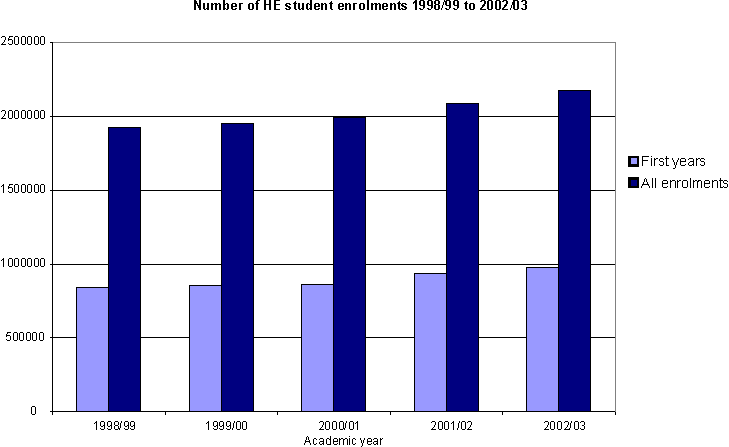Enrolment rises by 4.3%
First 2002/03 student enrolment data released
The Higher Education Statistics Agency released its first analysis of student data from the 2002/03 academic year today. The data shows that there were 2,175,115 enrolments on higher education courses at UK HE institutions compared to 2,086,075 in 2001/02. This equates to a rise of 4.3%. In 2002/03 there were 977,010 first year students compared with 938,350 in 2001/02.
The graph below shows the growth in student numbers over the past five years.

Female students made up 58% of the first year student population, unchanged from 2001/02. The biggest gender gap for first years was at the other undergraduate level (for example HNDs and HNCs) where 65% were female and 35% were male. This was an increase on the 2001/02 academic year when the gap was 64% and 36% respectively. This may be explained by the number of students enrolled on other undergraduate Nursing courses. At this level, 21% of first years were studying Nursing, which was by far the most popular subject choice. The huge gender gap can be accounted for by 89% of Nursing students being female.
58% (562,035) of first year students were studying full-time compared to 61% (1,318,065) of students from all years. This is an increase on 2001/02 when 56% and 60% were studying full-time respectively. Part-time modes of study were chosen by 42% (414,970) of first year students although this falls to 39% (857,050) when considering all enrolments. Overall this seems to indicate a swing from part-time study to full-time study when compared to 2001/02.
Full-time is the most popular mode of study for first year first degree (for example BA, BSc etc) students with 90% studying in this way, the same as in the previous year. The change in the choice for mode of study can be attributed to first year postgraduate students, 56% of whom chose to study full-time in 2002/03 compared to 54% in the previous year. There was, however, a slight increase in the number of first year other undergraduate students choosing to study part-time.
Of all of the first year students 41% were studying for a first degree. Meanwhile, postgraduate students made up 25% and other undergraduate students 34%. In 2001/02, 40% of first years were studying for a first degree and 35% for an other undergraduate qualification.
In 2002/03 a new subject classification was introduced called JACS. This subject classification looks similar to that previously published but has been devised in a different way. Therefore this subject data is not comparable to that previously published. We have also introduced a new procedure of apportionment for dealing with students on combined or split programmes of study. The table below shows the percentage breakdown of first year students at all levels and those at first degree level by subject area using these new methods.
| Percentage of first year students by subject area, 2002/03 | ||
|---|---|---|
| Subject area | First degree | All levels |
| Medicine & dentistry | 2.1% | 1.4% |
| Subjects allied to medicine | 8.9% | 13.0% |
| Biological sciences | 8.7% | 5.0% |
| Veterinary science | 0.2% | 0.1% |
| Agriculture & related subjects | 0.7% | 0.6% |
| Physical sciences | 4.2% | 2.7% |
| Mathematical sciences | 1.6% | 1.0% |
| Computer science | 7.6% | 6.2% |
| Engineering & technology | 7.0% | 5.4% |
| Architecture, building & planning | 2.2% | 2.0% |
| Social studies | 9.3% | 7.7% |
| Law | 4.8% | 3.8% |
| Business & administrative studies | 14.0% | 13.4% |
| Mass communications & documentation | 3.0% | 2.0% |
| Languages | 6.6% | 6.5% |
| Historical & philosophical studies | 4.5% | 3.9% |
| Creative arts & design | 9.8% | 6.0% |
| Education | 3.7% | 10.3% |
| Combined | 1.1% | 9.0% |
| Total | 100.0% | 100.0% |
The Business and Administrative Studies subject area proved to be the most popular amongst first degree students with Veterinary Science showing the least number of first year enrolments. Overall, Subjects Allied to Medicine and Business and Administrative Studies attracted the largest numbers of students at all levels of study.
Notes for Editors
- The table below shows the raw data for the graph above.
Number of HE student enrolments 1998/99 to 2002/03 Academic year First years All levels 1998/99 840450 1923530 1999/00 853050 1949335 2000/01 864985 1990625 2001/02 938350 2086075 2002/03 977010 2175115 -
Definitions
Coverage
Higher education (HE) students are those students on programmes of study for which the level of instruction is above that of level 3 of the National Qualifications Framework, i.e. courses leading to the Advanced Level of the General Certificate of Education (GCE A-levels), the Advanced Level of the Vocational Certificate of Education (VCE A-levels) or the Advanced Higher Grade and Higher Grade of the Scottish Qualifications Authority (SQA) Advanced Highers/Highers).
The HESA Student Record contains information about individual enrolments, which, because a student can be enrolled on more than one programme of study, will exceed the number of students. Postdoctoral students are not included in the HESA Student Record.
The HESA standard registration population has been derived from the HESA Individualised Student Record and ensures that similar activity is counted in a similar way irrespective of when it occurs. The population splits the student experience into ‘years of programme of study’; the first year of which is deemed to start on the commencement date of the programme with second, and subsequent years, starting on, or near, the anniversary of that date. Registrations are counted once for each ‘year of programme of study’. Short course registrations are counted in the standard registration population regardless of whether they are active on the 1 December of the reporting period. However students who leave within 2 weeks of their start date, or anniversary of their start date, and are on a course of more than two weeks duration, are not included in the standard registration population. Dormant students, incoming visiting and exchange students from overseas and students studying for the whole of their programme of study outside of the UK are also excluded from this population.
Rounding strategy
Due to the provisions of the Data Protection Act 1998 and the Human Rights Act 1998, HESA now implements a strategy in published and released tabulations designed to prevent the disclosure of personal information about any individual. These tabulations are derived from the HESA non-statutory populations and may differ slightly from those published by related statutory bodies. This strategy involves rounding all numbers to the nearest 5. A summary of this strategy is as follows:
- 0, 1, 2 are rounded to 0
- All other numbers are rounded to the nearest 5
So for example 3 is represented as 5, 22 is represented as 20, 3286 is represented as 3285 while 0, 20, 55, 3510 remain unchanged.
Total figures are also subject to this rounding methodology; the consequence of which is that the sum of numbers in each row or column will rarely match the total shown precisely.
Average values, proportions and FTE values prepared by HESA are not subject to the above strategy, and will be calculated on precise raw numbers. However, percentages calculated on populations which contain less than 50 individuals will be suppressed and represented as '..' as will averages based on populations of 7 or less.
Mode of Study (applies to HESA populations except the qualifications obtained population)
Full-time students are those normally required to attend an institution for periods amounting to at least 24 weeks within the year of programme of study, on thick or thin sandwich courses, and those on a study-related year out of their institution. During that time students are normally expected to undertake periods of study, tuition or work experience which amount to an average of at least 21 hours per week.
Part-time students are those recorded as studying part-time, or studying full-time on courses lasting less than 24 weeks, on block release, or studying during the evenings only. Part-time also includes students writing-up theses or on sabbatical, except where these have been tabulated separately.
Level of study
The level of study is taken from the qualification aim of the student.
Postgraduate programmes of study are those leading to higher degrees, diplomas and certificates (including Postgraduate Certificate of Education (PGCE) and professional qualifications) and usually require that entrants are already qualified to degree level (i.e. already qualified at level 3 of the National Qualifications Framework).
First degree includes first degrees with or without eligibility to register to practice with a Health or Social Care or Veterinary statutory regulatory body, first degrees with qualified teacher status (QTS)/registration with the General Teaching Council (GTC), enhanced first degrees, first degrees obtained concurrently with a diploma and intercalated first degrees.
Other undergraduate includes qualification aims below degree level such as foundation degrees, diplomas in HE with eligibility to register to practice with a Health or Social Care regulatory body, Higher National Diploma (HND), Higher National Certificate (HNC), Diploma of Higher Education (DipHE), Certificate of Higher Education (CertHE), foundation courses at HE level, NVQ/SVQ levels 4 and 5, post-degree diplomas and certificates at undergraduate level, professional qualifications at undergraduate level, other undergraduate diplomas and certificates including post registration health and social care courses, other formal HE qualifications of less than degree standard, institutional undergraduate credit and no formal undergraduate qualifications.
First year students
First year students are based on the HESA standard registration population who commenced their programme of study in the reporting period relevant to the data collection year.
Subject areas
From 2002/03, a new procedure of apportionment has been introduced. Under apportionment, each headcount is, where necessary, divided in a way that in broad-brush terms reflects the pattern of a split programme. This is analogous to the use of FTE calculations, but should not be confused with them, since the splits used for apportionment are conventional rather than data-based.
For split programmes not involving an initial teacher training (ITT) component, the apportionment algorithm is as follows:
- 50%:50% for a balanced two-way split
- 66.667%:33.333% for a major/minor two-way split
- 33.333%:33.333%:33.333% for a balanced three-way split.
ITT students at undergraduate level who also have a specialism subject recorded (typically, secondary ITT students) are apportioned 50% to the ‘Education’ subject area and the remaining 50% is further apportioned according to the algorithm for non-ITT students. Where no subject other than education is recorded, or where the student is on a PGCE course, apportionment is 100% to the ‘Education’ subject area.
The 19 broad subject areas have been retained.
- HESA is the central source for higher education statistics. HESA was set-up in 1993 following a Government White Paper ‘Higher Education: A New framework’, which called for more coherence in higher education statistics.
- Press Enquiries should be directed to Press Officer at HESA, 95 Promenade, Cheltenham, GL50 1HZ; telephone: 01242 211133.
Ends

Press Officer
